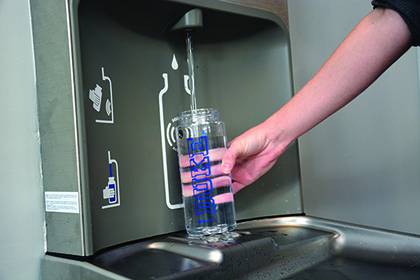Campus Water Stations Save 400,000 Plastic Bottles
Duke installs 50 water bottle filling stations

Duke community members are trading in disposable plastic water bottles for reusable ones, highlighting a growing effort to “take back the tap.”
With the help of water refilling stations across the university, Duke students, faculty and staff last year saved about 400,000 plastic bottles by filling up their own reusable containers. That’s enough bottles to stretch from West Campus to Greensboro.
Since January 2014, Duke has installed 50 water bottle filling stations in athletic and academic buildings throughout campus. In addition to a quick-fill tap that pours filtered water downward into bottles, the stations have a traditional water fountain attached. Each machine tracks the number of bottles saved, and Sustainable Duke staff compiles the savings.
“We’ve had students promoting reduced water use since 2009 through national campaigns like ‘Take Back the Tap’,” said Casey Roe, outreach coordinator for Sustainable Duke. “Plastic bottles take petroleum to make and gas to transport, so improving on-campus water infrastructure helps minimize our carbon footprint.”
Sustainable Duke has taken a proactive approach to not only promote installation of the new bottle-filling stations, but their use as well.
In partnership with the Nicholas School of the Environment, Sustainable Duke provides every first-year student with a reusable water bottle. For faculty and staff, Sustainable Duke offers assistance to supply water bottles as part the Green Workplace Certification process, providing reusable options for employees in Duke’s Leading for Environmental Sustainability Workshop.
“Ultimately, the goal is to reduce demand on campus for bottled water and change the mindset of how people can get it,” Roe said.
Last year, the most-used water bottle filling stations were located in the Bryan Center, Perkins Library and Gross Hall. Some of the newest stations getting heavy use are in the Brodie Recreation Center on East Campus. Installed in August 2014, one station in the men’s locker room tallied almost 4,000 water bottles saved in its first month. A second station is in the center’s weight room, and there are plans to install them in the women’s locker room.
“Most of our members do bring their own water bottles, so it’s been great for them to be able to refill easily and know they’re not wasting any more bottles in the process,” said Meghan Weiseman, facility coordinator for Brodie. “The new stations help you fill a whole bottle in a few seconds and you can go about your day.”